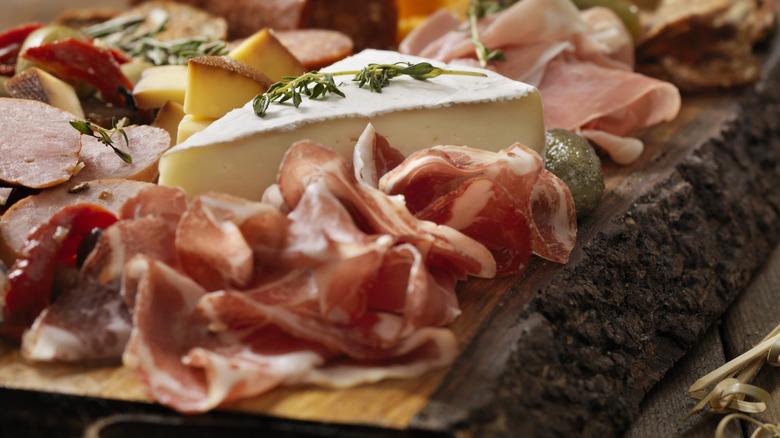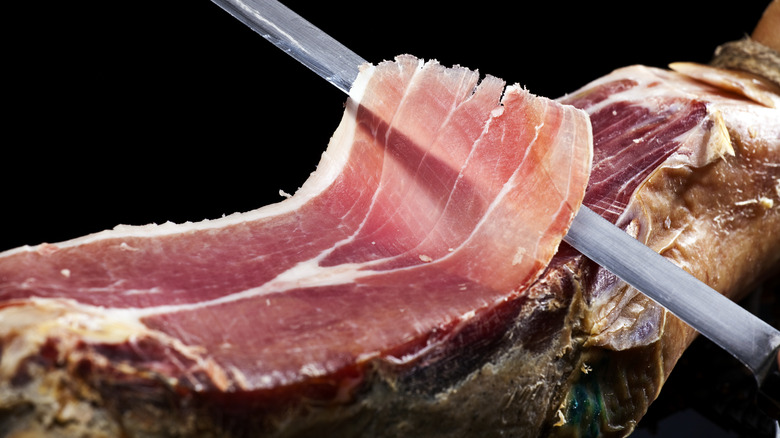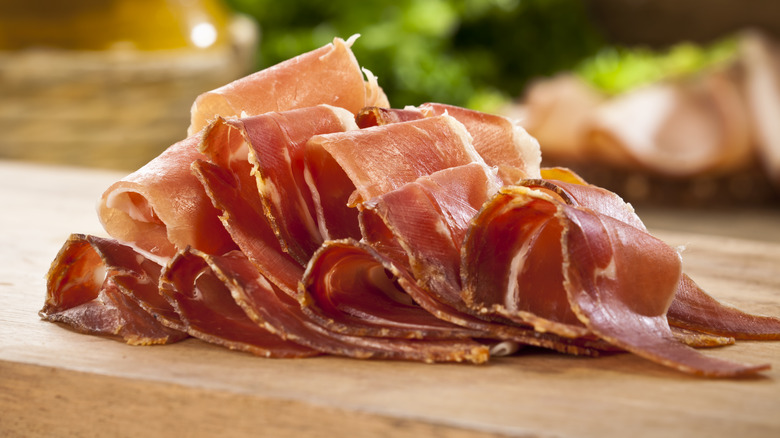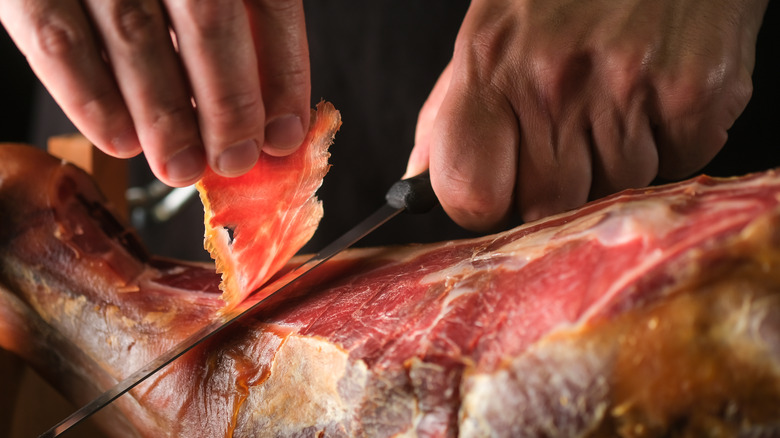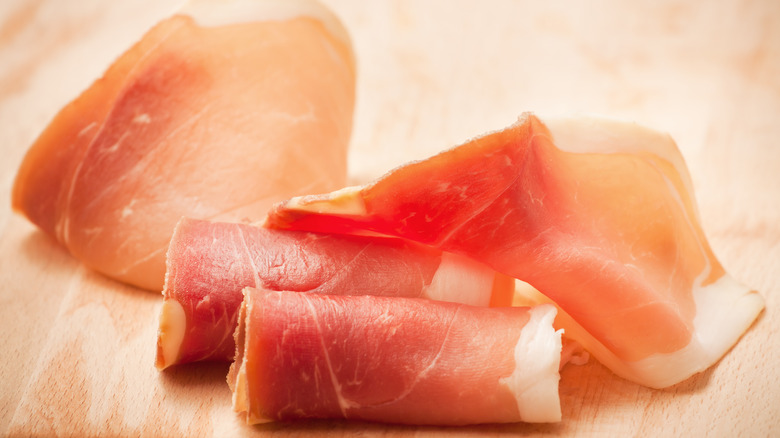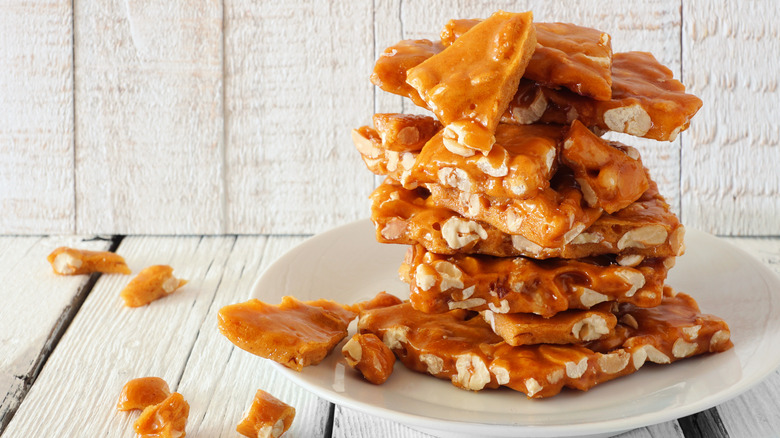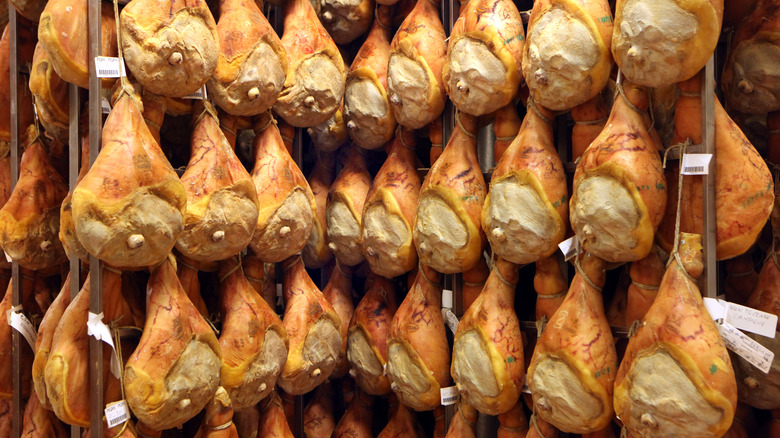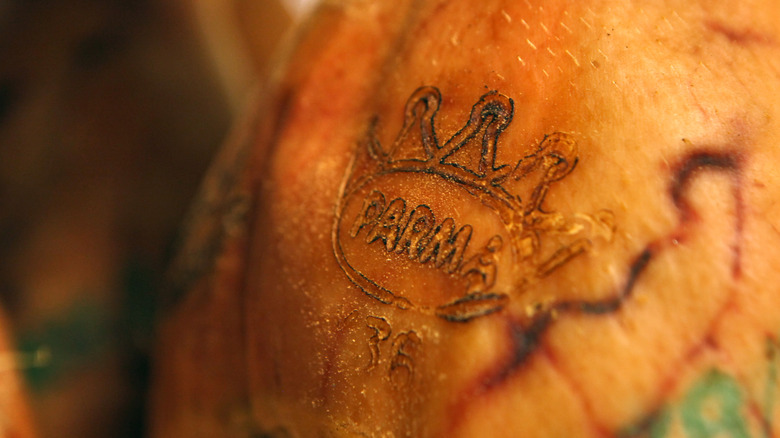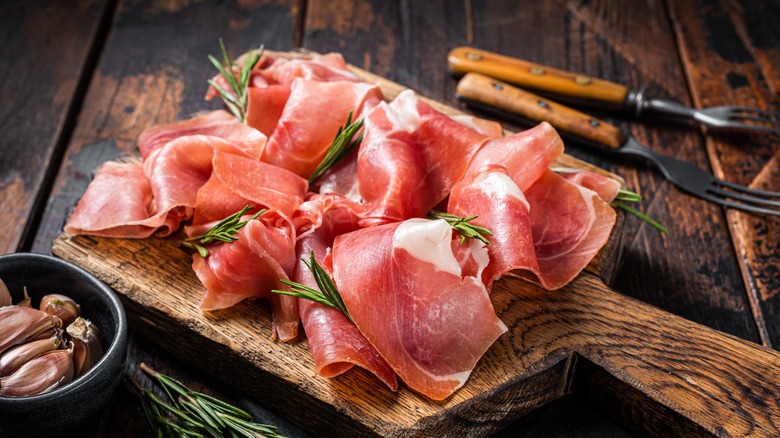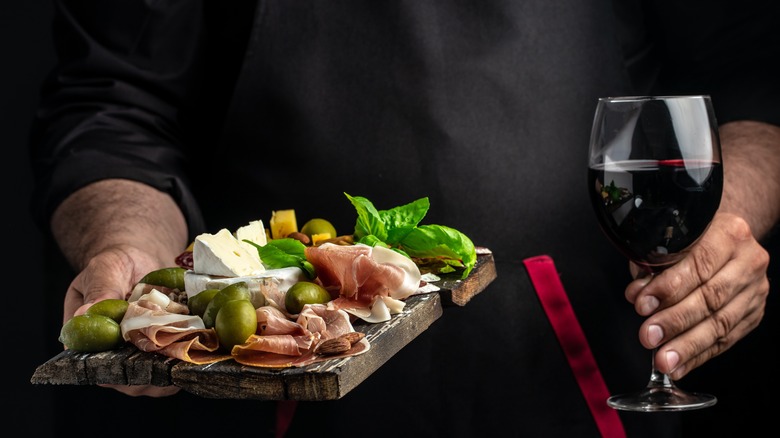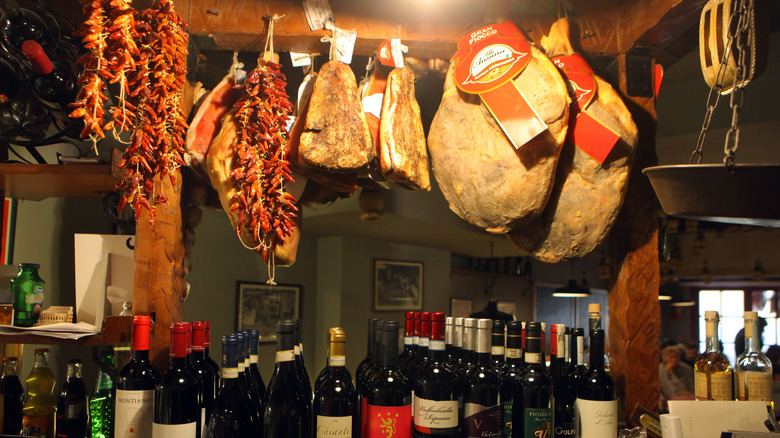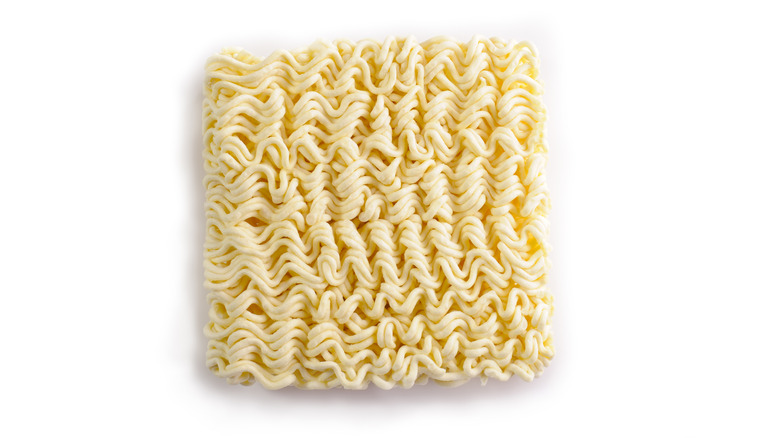16 Things You Didn't Know About Prosciutto
The Italian word "prosciutto" simply means ham — but there's a world of difference between classic cured prosciutto and the watery squares of supermarket ham that found their way into your lunchbox when you were a kid. When most of us hear the word prosciutto, we think of prosciutto di Parma or one of its close relatives: dense, complexly flavored long-cured ham, typically served in paper-thin slices. For those who find typical boiled ham bland and boring, prosciutto can be a revelation — its salty-sweet, pleasantly gamey flavor and melt-in-your-mouth texture are unforgettable.
While the practice of salting and curing meat first started in Italy as a practical means of food preservation, it has since evolved into an art form. Making traditional prosciutto basically involves salting the meat (always the hind leg of a pig) and aging it in a protected environment to dry and develop its flavors, but learning to do this properly takes years of training. Today, prosciutto is no longer a survival food, but a point of pride in the regions of Italy that make it — and a beloved treat elsewhere.
There are two types of prosciutto
When most people in North America hear the word "prosciutto," they have a very specific food in mind: The thinly sliced, deeply flavored dried ham imported from Italy or made in the Italian style. But in Italy, prosciutto is just a generic term for ham, and can refer to one of two types of traditional Italian ham: The raw, dry-cured prosciutto most of us think of when we hear the term (prosciutto crudo) and cooked prosciutto (prosciutto cotto), which is a bit closer to American deli ham.
The two types of Italian prosciutto differ, both in how they are made and how they taste. Prosciutto cotto is brined then steamed, and is sometimes seasoned with herbs, spices, or truffles. It is soft, pale pink, and the more mildly flavored of the two types. In contrast, prosciutto crudo is made by carefully salt-curing and drying a raw ham, a process that can take up to three years. The resulting ham is deeper in color, drier and denser than fresh ham, and more deeply flavored.
Yes, cured prosciutto is raw – but perfectly safe to eat
Most have heard the warning that pork needs to be thoroughly cooked to be safe to eat, since cooking kills off pathogens carried by pork. But prosciutto crudo is completely raw — at no point in its production process is it heated. While it can be used in cooked dishes, by tradition, it's simply thinly sliced and served cool or at room temperature.
So, why can prosciutto crudo be eaten safely (and quite happily) in its uncooked form? Raw prosciutto is safe because the curing process, if done correctly, draws out moisture and any existing bacterial from the raw meat, and the salt and cool temperatures used in the curing process protect the meat from future contamination. While the salt serves as an effective preservative, it's applied judiciously at the start of the curing process; trained artisans apply just enough salt to cure the meat safely, so it's less salty than other cured hams. This means that unlike some other types of cured ham, such as American country ham, it can be eaten as-is without being pre-soaked and cooked (a precaution to remove excess salt).
Real prosciutto de Parma contains no seasonings other than salt
The deep, complex flavors of traditional prosciutto may lead you to think a master spice blender must have been at work in its creation. But in reality, the ingredient list for traditional raw prosciutto contains only a few entries: meat, salt, and a bit of lard (and an optional bit of pepper), applied before the final stage of curing.
But reputable prosciutto producers will tell you that two other key ingredients are essential to achieve the proper flavor: time and skill. Making prosciutto is anything but a quick process. First, salt is applied to the raw ham, which is then refrigerated for week. After a second layer of salt is added, the ham rests in the refrigerator for 18 days before being hung in a refrigerated room for two to three months to ensure the salt is evenly distributed. Next, any unabsorbed salt is washed off and the first stage of curing — which lasts three months — begins. Then, the prosciutto-in-progress is rubbed with lard and salt to prevent the exterior from drying out too quickly before the final stage of curing begins. For prosciutto di Parma, the minimum curing time (from the date of the first salt application) is 400 days.
Traditionally, prosciutto is inspected and tested using a horse bone needle
In Italy, making prosciutto the traditional way is a painstaking process that requires patience and a careful hand. Even the seemingly straightforward matter of salting the raw ham to start the drying and curing process requires knowledge and skill. Expert salters must be able to judge the optimal amount of salt to apply to each ham: Too much and the prosciutto will end up unpleasantly salty; too little, and the meat may spoil.
For the famed prosciutto di Parma, made in the Emilia-Romagna district of Italy, each ham must undergo an additional step after the final curing: a visual inspection and sniff test by a specially trained inspector — only hams that pass this rigorous inspection can be sold as prosciutto di Parma. During inspections, the inspector pierces each ham in five locations with a long needle, sniffing after each piercing for any off odors. By tradition, these special long testing needles are made from a horse's shinbone – the bone is porous enough to absorb aromas quickly upon contact with the ham, but releases them just as quickly, allowing the needle to be used for back-to-back sniff tests.
In the Italian district of Parma, only certain pigs can be used for prosciutto
Because traditional cured prosciutto contains only two ingredients — meat and salt — the quality of these base ingredients is critical. For this reason, producers of the famed prosciutto di Parma must follow strict guidelines for procuring their pork.
Pigs can only belong to certain heavy breeds (among them, traditional breeds such as Large White and Duroc) and must weigh around 160 kilograms. They also must be fed a high-protein diet, which often includes whey from the production of Parmesan cheese, another local specialty.
But these aren't the only requirements these pigs must meet. To earn the prosciutto di Parma designation, hams must be made not only from pigs of certain breeds and sizes, but from pigs raised in designated areas and processed in authorized slaughterhouses. Each ham comes with a detailed chain of custody, from markings made by breeders on the young pigs to identification stamps from the slaughterhouse to metal tags affixed to each ham upon its arrival at the production facility. This means could theoretically trace the progression of your last taste of prosciutto di Parma from the birth of the pig to the time it went on the market.
Two districts in Italy are known for their prosciutto
While prosciutto di Parma is the best-known variety of Italian prosciutto in the U.S., cured prosciutto is produced in various areas of Italy. Besides prosciutto di Parma, a second Italian variety called prosciutto di San Daniele, in the Friuli Venezia-Giulia region, has a reputation for exceptional prosciutto. Both varieties claim the special status of Denominazione di Origine Protetta, or protected designation of origin, meaning that products claiming this designation must be made in their specified regions following strict local standards.
While both Parma and San Daniele prosciutto are made only from the hind legs of selected local pigs and are cured with just salt, some slight differences in production technique differentiate them. San Daniele prosciutto tends to be made with larger hams than Parma prosciutto, and while San Daniele prosciutto is cured with just a coating of dry salt, Parma prosciutto is salted with both moistened and dry salt. In addition, San Daniele prosciutto is dried for a shorter period than Parma prosciutto (this could be in part because the San Daniele region is dryer and less humid than the region where Parma prosciutto is made). Both types are highly regarded and have their fans – Parma prosciutto is sweeter, while San Daniele prosciutto has a more mature, aged flavor profile.
Prosciutto dates back to ancient times
Prosciutto is more than a traditional favorite in Italy — it is the result of thousands of years of gradual development and evolution. Writings of Cato the Elder dating to 200 B.C. describe Roman methods of dry-curing pork legs, and a written recipe for dried, cured pork legs dating to 37 A.D. portray the method as common in the area now known as Parma. Prosciutto even played a role in Italian historical legends; it is said that when Hannibal conquered the Romans at the Trebbia River, locals paid their tribute by serving (and reportedly impressing) him with salted, cured ham.
In the San Daniele region, the culture of formal prosciutto making began to emerge in the 11th century; by the Renaissance, the area had already earned its current reputation as an epicenter of prosciutto production. Then, as now, San Daniele prosciutto was highly regarded: It was presented as a gift to the bishops at the 1563 Trento assembly, and later became a favorite of Napoleon.
Prosciutto makes a surprisingly good pairing with sweets
It's hard to turn down prosciutto — there's a good reason it's so popular as a pizza topping, a panini filling, and as a flavorful wrapper for plain breadsticks. Prosciutto paired with figs or melon slices always makes for a refreshing and lively first course, and there are other great pairings as well. But there's no reason to limit yourself to the classics. Despite its long history and the strong traditions built around it, prosciutto is way more versatile than you might think.
For instance, fresh fruit isn't the only possible sweet accompaniment for prosciutto. Imaginative fans have been exploring ways to work a gentle pop of salty prosciutto into other sweets.
"I like to make peanut brittle with pieces of prosciutto inside," Cesare Casella, restaurateur and founder of Casella's Salumi, told La Cucina Italiana. "It's a good pairing of sweet and salty."
If you enjoy regular smoked ham with a sweet glaze, you'll love candied prosciutto, which is not only delightfully different, but easy to make. Just lay slices of prosciutto on a parchment-lined baking sheet, top with a thin layer of brown sugar, and bake at medium heat until the sugar is caramelized and glossy. Enjoy as a snack on its own or crumble and use as a sophisticated stand-in for bacon bits.
Crispy, dried prosciutto makes a festive garnish for drinks
By tradition, cured prosciutto is intended to be served as is — after all, if it took a group of trained artisans a year or more to prepare and cure it, it seems only respectful to appreciate their handiwork in its most basic form, without distractions. But realistically, most folks aren't going to be eating authentic prosciutto di Parma on the regular. They are much more likely to go for a more affordable American-made version of prosciutto.
Having a source of decent, affordable prosciutto gives permission to experiment. A fun way to change up prosciutto is by crisping it in the oven; just lay the slices on a parchment-lined baking sheet and bake at medium-high heat until it shrinks and turns brittle. The crispy shards make great toppings for salads and pasta, as well as good snacking on their own. But restaurateur and prosciutto maker Cesare Casella proposes an even more creative use for crisped prosciutto: using it as a garnish for a Bloody Mary.
If you get a whole prosciutto leg, here's how to care for it
Prosciutto is so intensely flavored that it is typically purchased and consumed in modest quantities. Most will only ever purchase it pre-sliced, either prepackaged or hand-sliced directly from the whole leg, for those lucky enough to find a deli that offers this option. It's far less likely you'll ever find yourself with a whole leg of prosciutto –- but if you do, you should take special care to protect it.
First, make room in the refrigerator — it'll keep best if stored chilled and in its original packaging. A vacuum-sealed whole prosciutto can maintain its quality for about a year if kept refrigerated. Once opened, the leg will hold for about two months in the refrigerator. Bone-in prosciutto legs can arrive with some mold on the outside (a normal artifact of the curing process); this can be simply wiped off. You almost certainly won't be eating the whole thing at once, so remember to keep it tightly wrapped in plastic between servings. To maintain the purity of its flavor and aroma, avoid storing it near strong-smelling foods such as onions. Also avoid the temptation to put the leftovers in the freezer — this will ruin the prosciutto's texture and flavor.
Here's the best way to store sliced prosciutto
Most supermarket packages of pre-sliced prosciutto are pretty small, so as far as parties are concerned, there's a good chance it won't last through the evening. But if storing it for the occasional nibble, how long will it be safe to savor prosciutto from the package before it goes bad?
As long as the package is vacuum sealed, sliced prosciutto should stay fresh in the refrigerator for up to four months. Once the package is opened, however, the clock starts ticking faster; sliced prosciutto should be consumed within three days of being exposed to air. Once the package is open, look for any signs the meat is starting to degrade, such as discoloration, off odors, or a slimy film on the surface — a sure sign the meat is starting to break down.
Prosciutto pairs well with a range of wines and spirits
One of the reasons prosciutto is so much fun to serve and eat at parties is that its sweet-salty flavor and complex aroma make it a terrific match for a range of foods and drinks.
For instance, it pairs well with both red and white wines. If you prefer reds with your prosciutto, choose varieties with a medium body and moderate tannins, such as Chianti and Pinot Noir; heavier, oaked varieties tend to overwhelm, rather than complement, the flavors of your prosciutto. For white wine, pair prosciutto with a light, acidic variety such as Sauvignon Blanc or Pinot Grigio. These wines will contrast nicely with the fattiness of prosciutto without overpowering its unique flavors. Avoid sweeter white wines, which will definitely overpower it. Lighter, more austere wines are solid partners for prosciutto, so a dry rose or sherry would also be a good match.
Not a wine drinker? There are still plenty of beverage pairing options to enhance the prosciutto experience. Lighter beers, such as lagers or wheat beers, are a refreshing option, as are clear spirits like vodka or gin.
Italian prosciutto was banned from the U.S. for almost 20 years
Italy is where cured prosciutto was invented, and it is home to the world's best-reputed prosciutto varieties. But even as Tuscan and other regional Italian dishes and ingredients started making their way to American menus and American diners discovered that Italian food meant more than spaghetti and meatballs with red sauce, one imported Italian specialty was conspicuously missing: prosciutto. This wasn't because American diners didn't care for it; there was plenty of American-made prosciutto around. But in 1967, an outbreak of African swine flu in Italy moved the USDA to ban the importation of some Italian meats, including prosciutto.
During this time, fans of authentic prosciutto di Parma or prosciutto di San Daniele had to either do without or travel abroad to get their fix. Enterprising Italian food producers attempted to get around the ban by launching prosciutto-making operations in the U.S., but without the original ancient breeds of pigs and terroir, the taste wasn't quite the same. Even worse, the ban seemed to go on forever; it wasn't lifted until 1989.
American prosciutto makers are striving to up their game
Competing against an undisputed champion is either a sign of profound confidence, or jaw-dropping stupidity. Trying to create a high-end version of a centuries-old culinary specialty deeply rooted in the geography and traditions of its place of origin sounds like a recipe for humiliation. Nevertheless, this hasn't stopped ambitious Americans from attempting to make their own long-cured prosciutto.
High-profile purveyors such as Nieman Ranch now offer prosciutto cured and aged the traditional way, with just salt and no nitrates or other additives. Some of this homegrown prosciutto is attracting notice for its compelling flavor.
For instance, prosciutto from Iowa-based producer La Quercia (quercia being the Italian word for "oak," a traditional symbol of the Parma province as well as the state tree of Iowa) was called "the best American prosciutto on the market" by Mario Battali, and top chefs including Wolfgang Puck and Emeril Lagasse use it in their kitchens. La Quercia uses Italian-made equipment and traditional curing methods, but the company is proud to represent itself as a homegrown American company featuring American ingredients. "We are proud of the quality of meat raised by our farmers here," La Quercia co-founder Herb Eckhouse told Italy Magazine in 2013.
To mix things up, try putting prosciutto in ramen
Prosciutto is so deeply identified with Italian food culture that it's easy to limit its uses to traditional Italian dishes. But its complex, savory flavor can complement dishes from a range of culinary traditions –- for instance, baked, crisped prosciutto would make a great garnish for a baked potato or even a creamy bowl of soup.
Creative cooks have dug deep into exploring prosciutto's culinary potential, and one innovation many have embraced is using prosciutto in ramen. The pairing of a traditional Japanese dish with a distinctly Italian flavoring sounds odd, but actually makes sense: Ramen broth is known for its distinct umami characteristics, as is prosciutto – the prosciutto basically supercharges the flavor of the already succulent broth.
One way to elevate a packet of instant ramen is by adding torn prosciutto, poached eggs, and cooked veggies such as kale (make your own broth using kombu or use part of the flavoring packet that came with your ramen). Another variation incorporates another umami bomb, Chinese XO sauce (made with shredded dried scallops, chilies, and other flavorings) along with crisped prosciutto. Both top a bowl of instant ramen to turn it into something new and original.
Prosciutto and melon is a classic – but try these fruit pairings too
The salty-sweet taste of prosciutto makes it a classic foil for a ripe slice of melon, and a slice of prosciutto draped over a melon slice is the simplest appetizer imaginable. But the same qualities that make prosciutto a great partner for melon make it a tasty match for other fruit as well. So, if you're a prosciutto fan but are getting tired of the same familiar preparations — or you simply don't have ripe melon around — you have other fun options.
An unexpected pairing that would be a refreshing starter for a winter dinner would be layering sliced oranges with torn prosciutto, thinly sliced Pecorino Romano, and pistachios. A sprinkling of chopped fresh mint, black pepper, and olive oil is all you need to complete the dish. Or try sliced, ripe fuyu persimmons layered with creamy burrata cheese and prosciutto, with a garnish of fresh mint and olive oil. But if you'd like to try an original variation of the classic melon with prosciutto, try balls of honeydew tossed with chopped olives, a touch of chile, torn prosciutto, and a little mint. A sprinkle of olive oil is the only dressing this salad needs.

